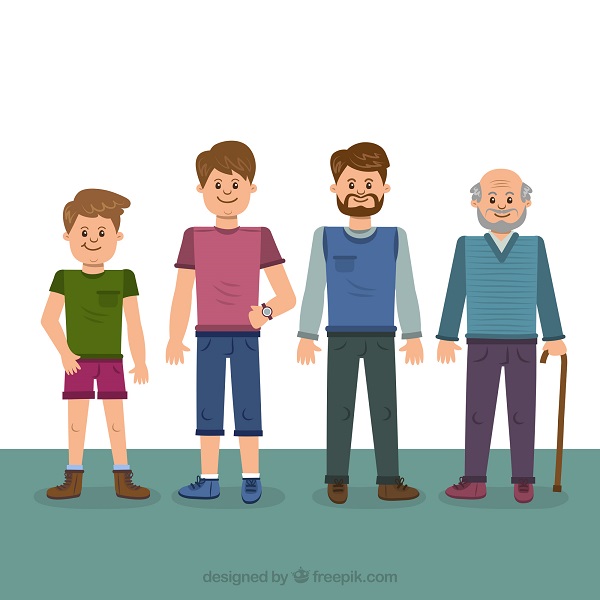Ad

We all know that for men, height can continue to increase until around the age of 20, while for women, it often reaches its peak by about age 14, typically around the onset of menstruation. But what about the other side of the spectrum—shrinking with age?
Most of us have heard that people tend to shrink as they get older. We might have seen it with our own eyes in our family and friends. But is there truth behind this common belief? For many, the idea of losing even an inch or two from their height can feel unsettling, especially if standing tall has been a point of pride. But what’s the science behind this phenomenon, and how does it actually affect us over time?
Shrinking with age is a gradual process influenced by multiple factors – from changes in bone density and joint health to the body’s natural wear and tear.
In this blog, we explore why height decreases with age, the extent of this height loss, and some ways to help keep you standing tall longer.
Why do you tend to get shorter as you age?
As we age, various changes in our body contribute to height loss. One significant reason is the gradual compression of the spinal discs, the soft, gel-like cushions between our vertebrae. These discs absorb shock and keep the spine flexible, but over time, they lose moisture and elasticity, which makes them thinner and less effective. The cumulative effect of this disc compression can reduce spinal length, ultimately affecting our height.
Bone density also plays a crucial role. Throughout life, bones continuously break down and regenerate, but with age, the rate of regeneration slows down, especially in those who develop osteoporosis, a condition that weakens bones. Lower bone density not only increases the risk of fractures but can also contribute to a reduction in spinal height as the vertebrae become more compressed or even fractured.
Additionally, muscles that support posture tend to weaken with age. Muscles like the core and those surrounding the spine can weaken without regular activity, leading to a slight hunch in posture. This rounded posture, known as kyphosis, may add to perceived height loss, making you appear shorter than you actually are.
How much do you shrink?
The amount of height loss varies greatly from person to person, depending on genetics, lifestyle, and overall health. On average, it’s typical for men to lose about 1.25 inches (around 3.2 cm) of height over their lifetime, while women may lose up to 2 inches (about 5 cm). Women tend to lose slightly more height due to generally having lower bone density than men and are also more susceptible to osteoporosis after menopause.
Height loss doesn’t happen all at once but progresses gradually, often beginning in the 40s or 50s. In your 60s, height loss may become more apparent, and by your 70s or 80s, a noticeable change in height may have occurred. Those who lead a sedentary lifestyle, lack weight-bearing exercise or have poor diets are likely to experience more significant height loss than their more active counterparts. However, a healthy, balanced lifestyle with regular exercise can help slow this process to a large extent, preventing severe height reduction.
How can you avoid height loss?
While it’s impossible to entirely avoid the ageing process, there are steps you can take to minimise height loss and support a strong, healthy spine throughout life. Here’s how:
Exercise regularly
Exercise is essential for preserving bone and muscle strength. Weight-bearing exercises like walking, jogging, or resistance training encourage bone regrowth and can help prevent osteoporosis. Activities like yoga and Pilates strengthen core muscles and improve flexibility, supporting better posture and reducing the risk of height loss due to poor alignment.
Calcium and vitamin D
A balanced diet rich in calcium and vitamin D is critical for bone health. Calcium strengthens bones, while vitamin D ensures proper calcium absorption. You can get calcium from dairy products, leafy greens, and fortified foods, while vitamin D is found in fatty fish and through sunlight exposure. Supplements can also help if needed, especially as the body’s ability to absorb calcium naturally declines with age.
Posture awareness
Good posture not only makes you look taller but also helps to prevent long-term spinal issues. Simple practices like sitting up straight, using ergonomic furniture, and keeping screens at eye level can contribute to better spinal health. Strengthening your core muscles also provides greater support to the spine, helping prevent a hunched back.
Avoid smoking and excessive alcohol consumption
Smoking and heavy alcohol intake negatively affect bone health. Smoking reduces bone density and increases the risk of osteoporosis, while excessive alcohol disrupts the balance of calcium in the body, affecting bone strength.
Routine health check-ups
Regular bone density tests, especially after the age of 50, can help detect early signs of osteoporosis or other issues that could contribute to height loss. Early detection allows for timely interventions, such as medication or lifestyle changes, that can slow the progression of bone density loss.
Closing thoughts
Height loss with age is a natural process that most people experience to some degree. Although genetics play a part, lifestyle factors such as regular exercise, balanced nutrition, and good posture can go a long way in maintaining height. So, while shrinking with age may be inevitable, a few simple adjustments to your daily routine can help you stay strong and upright.
Book Your Full Body Health Checkup Today
Ad

